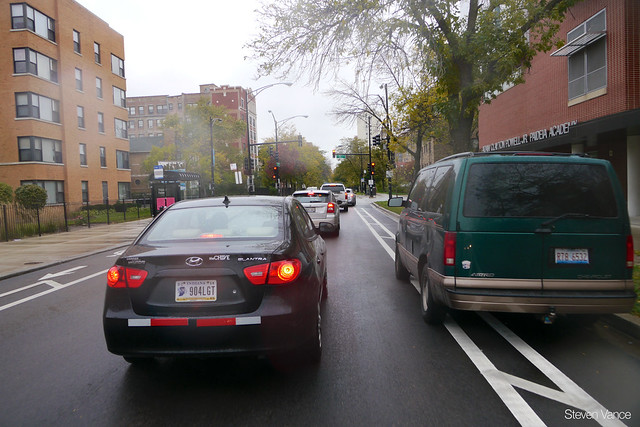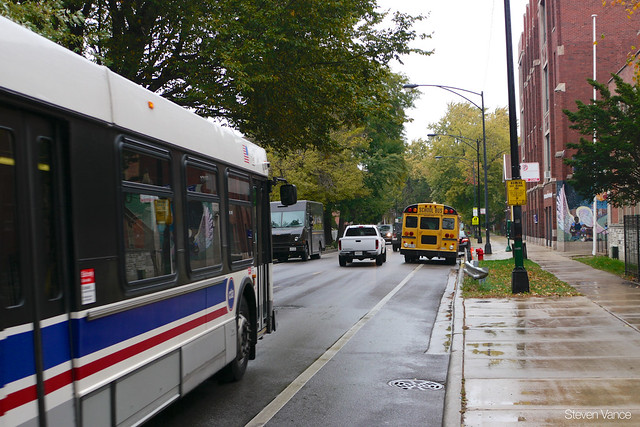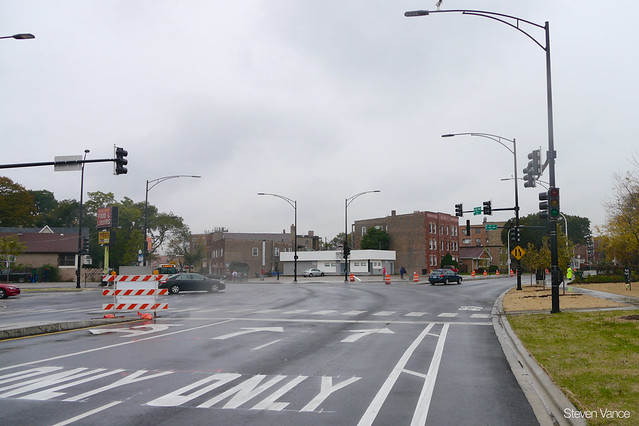New Bikeways Week pedals ahead as we look at new and upgraded bike lanes all over the city. Yesterday I visited the Lakeside development in South Chicago to get a tour in anticipation of the grand opening of what's known as the South Lake Shore Drive extension. After that, I checked out 1.25 miles of upgraded bike lanes on a recently repaved section of South Shore Drive, a northwest-southeast diagonal road, between 71st and 79th streets.
South Shore is a key connection for cyclists continuing south from the terminus of the Lakefront Trail at 71st, or north towards the trail from the Southeast Side. It's a residential street with no curbside parking and therein lies the greatest problem with the bike lanes.
For many years South Shore's pavement quality was quite awful. Last winter a poorly addressed sewer cave-in at 73rd formed a small ice rink and caused several people to crash on their bicycles.
From 71st to 79th streets, lousy pavement is no longer an issue. The street has been repaved to be silky smooth, and the bike lanes were widened from five feet to six feet, including a new two-foot striped buffer on the left side of the lane. The buffer actually narrows the usable portion of the bike lane from five feet to four feet, but overall the change is a safety win because it encourages drivers and cyclists to keep more distance from each other's vehicles.
South of 79th, the bike lanes were simply restriped this spring in the original five-foot configuration over the existing pock-marked pavement. This isn't your typical potholed street: the divots are frequent and they always seem to be located in the bike lane. This forces cyclists to make a decision every few hundred feet: "Should I merge into traffic to avoid this pothole, or can I roll over it without bending my wheel?"
There are no curbside car parking lanes on the repaved stretch of South Shore – there's no room to add one – and people park cars, delivery trucks, and school buses up and down the bike lane. This endangers bicyclists by forcing them to merge into traffic. Parking enforcement or the addition of flexible posts would help clear the lane of encroaching motorists.
If I took a photo of each illegally parked car during my short journey from 83rd to 71st, I would have missed the Metra train home. If you don't care to navigate around these hazards, a low-traffic alternative is Exchange Avenue, which runs parallel to South Shore, two blocks west, and it's also easily accessed from the Lakefront Trail terminus.
One other problem on this stretch of South Shore was created during last year's reconstruction of the intersection with 79th Street. The rebuild widened the travel lanes on both streets, increased pedestrian crossing distances, and widened turning radii at corners, which makes it easy for drivers to whip around them at high speeds. What was once a standard, right-angle urban intersection now feels more like a curvy, suburban-style speedway.
The changes at this intersection create a right-hook issue for cyclists traveling north on South Shore. Southbound cyclists must share a lane with cars because the bike lane ends before it reaches 79th. Westbound cyclists on the new 79th bike lane who are turning right onto northbound South Shore face the issue of being passed closely and fast because of the wide turn radius. In general, cyclists now spend more time exposed to fast traffic than they did in the previous design.
The car-centric, bike-and-ped-hostile reconfiguration of this intersection comes as no surprise since the backward-thinking Illinois Department of Transportation was heavily involved in the design. One small change that would mitigate this bad design somewhat would be striping dashed bike lanes through the intersection on all legs.
Once the South Lake Shore Drive extension opens, providing an alternative to South Shore between 79th and 87th, traffic on South Shore south of 79th may decrease somewhat, but the parking problem won't go away without some additional enforcement or engineering attention.








